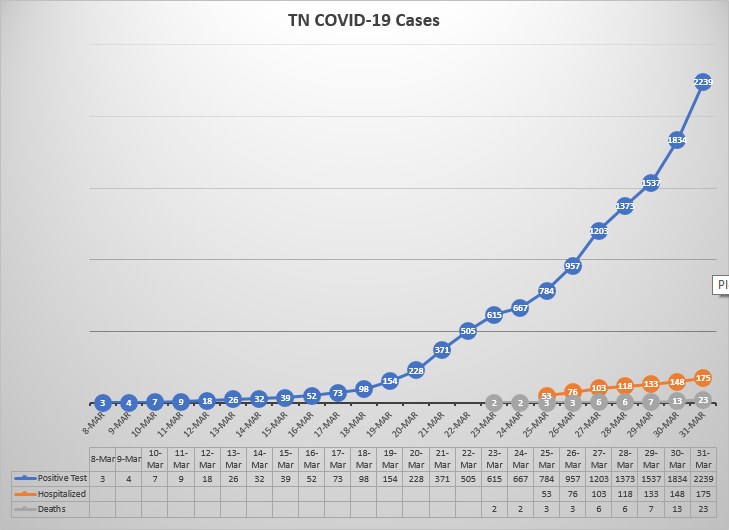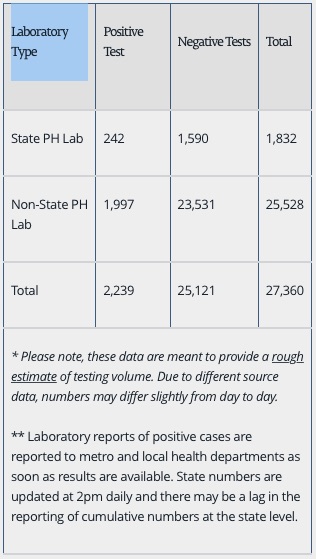
Note This story was last updated at 8:30 a.m. April 1.
The number of COVID-19 cases in Tennessee passed 2,000 on Tuesday. The Tennessee Department of Health reported 2,239 cases, 23 deaths, and 175 hospitalizations due to COVID-19, a contagious respiratory illness that can be deadly.
The number of cases in Tennessee increased by 405. That was a 22 percent increase from Monday, when there were 1,834 cases.
The 23 deaths reported Tuesday were up from 13 on Monday. The state doesn’t currently list the counties where the deaths occurred.
The state also does not report which counties the hospitalizations occurred in, and it’s not clear how many of the patients remain in the hospital.
The Tennessee Department of Health publishes the state case totals at 2 p.m. Central time each day.
There are now 10 cases in Anderson County, up from nine on Monday and double the five reported on Thursday. There have been 139 COVID-19 tests of Anderson County patients. Of those, 10 were positive, and 129 were negative.
Case totals in Shelby County and Davidson County approached or passed 400. Shelby County, which includes Memphis in West Tennessee, now has 428 cases, and Davidson County, which includes Nashville in Middle Tennessee, has 391.
Seven Nashville-area counties have 851 total cases: Cheatham (10), Davidson (391), Robertson (28), Rutherford (68), Sumner (184), Williamson (131), and Wilson (39). That’s about 38 percent of the state’s total.
Two Memphis-area counties in West Tennessee, Fayette and Tipton, have 12 and 21 cases, respectively. But it’s not clear how many cases might be in surrounding counties in Arkansas and Mississippi.
Knox County, which includes Knoxville in East Tennessee, has 66 cases, and Hamilton County, which includes Chattanooga in southeast Tennessee, has 48 cases.
Besides Knox County, here are the case totals in other counties surrounding Anderson County: Campbell (4), Loudon (8), Morgan (1), Roane (2), Scott (2), and Union (1).
There have been a total of 27,360 COVID-19 tests across the state. The 2,239 positive tests are about 8.2 percent of the total tests, and the 25,121 negative tests are about 91.8 percent of the total.
Demographically, the largest number of cases is still in patients who are 21 to 30 years old. There are 566 cases, or about 25 percent of the total, in that age group.
There are more than 300 cases each in the next three age groups: 31-40 years old (346 cases), 41-50 (351), and 51-60 (368). The four age groups, from 21 to 60 years old, account for 1,631 cases, or about 73 percent of the state’s total.
The percentage of patients who have tested positive and been hospitalized in Tennessee is about 7.8 percent so far (175 hospitalizations out of 2,239 cases).
The percentage of patients who have tested positive and died in Tennessee is about 1 percent so far (23 deaths out of 2,239 cases).
The Tennessee Department of Health reported Tuesday that 121 patients have recovered from COVID-19.
COVID-19 is caused by a new coronavirus that was first reported in Wuhan, China, in December. Since then, it has spread around the world, infecting more than 840,000 people and killing more than 40,000. There are more than 180,000 cases in the United States, where more than 3,600 people have died as of Tuesday afternoon, March 31.
For most people, around 80 percent of more, according to various reports, the virus causes mild, moderate, or serious symptoms that can include days-long fevers, headaches, body aches, fatigue, and cough. Some people may not show symptoms at all. But for others, especially older adults and people with existing health problems, the virus can cause severe symptoms like pneumonia and lead to hospitalization, intensive care, or even death. Health officials caution that young patients might be less vulnerable overall, but they can still succumb to the disease and might help spread the illness even if they don’t get sick.
Across the world, the virus has led to quarantines and other disruptions to daily lives, including school and business closures; lockdowns and shutdowns; some hoarding and panic buying at grocery stores; travel bans and closed borders; and economic slowdowns and large number of job losses.
Globally, more than 170,000 patients are reported to have recovered from COVID-19.
Here are the county totals of COVID-19 in Tennessee as of Tuesday, March 31, 2020:
- Anderson—10
- Bedford—2
- Benton—4
- Bledsoe—2
- Blount—25
- Bradley—10
- Campbell—4
- Cannon—3
- Carroll—5
- Carter—1
- Cheatham—10
- Chester—3
- Claiborne—2
- Cocke—1
- Coffee—1
- Cumberland—11
- Davidson—391
- DeKalb—
- Dickson—17
- Dyer—3
- Fayette—12
- Fentress—1
- Franklin—5
- Gibson—6
- Giles—3
- Greene—12
- Grundy—4
- Hamblen—2
- Hamilton—48
- Hardeman—1
- Hardin—1
- Hawkins—4
- Haywood—2
- Henry—1
- Houston—1
- Humphreys—2
- Jefferson—6
- Johnson—2
- Knox—66
- Lawrence—2
- Lewis—2
- Lincoln—1
- Loudon—8
- Macon—4
- Madison—5
- Marion—5
- Marshall—1
- Maury—15
- McMinn—3
- McNairy—1
- Meigs—1
- Monroe—5
- Montgomery—19
- Morgan—1
- Obion—1
- Overton—2
- Perry—2
- Putnam—24
- Rhea—1
- Roane—2
- Robertson—28
- Rutherford—68
- Scott—2
- Sequatchie—1
- Sevier—8
- Shelby—428
- Smith—2
- Sullivan—13
- Sumner—184
- Tipton—21
- Trousdale—4
- Unicoi—1
- Union—1
- Warren—1
- Washington—14
- Wayne—1
- Weakley—1
- White—1
- Williamson—131
- Wilson—39
- Non-Tennessee resident—190
- Unknown—307


Leave a Reply